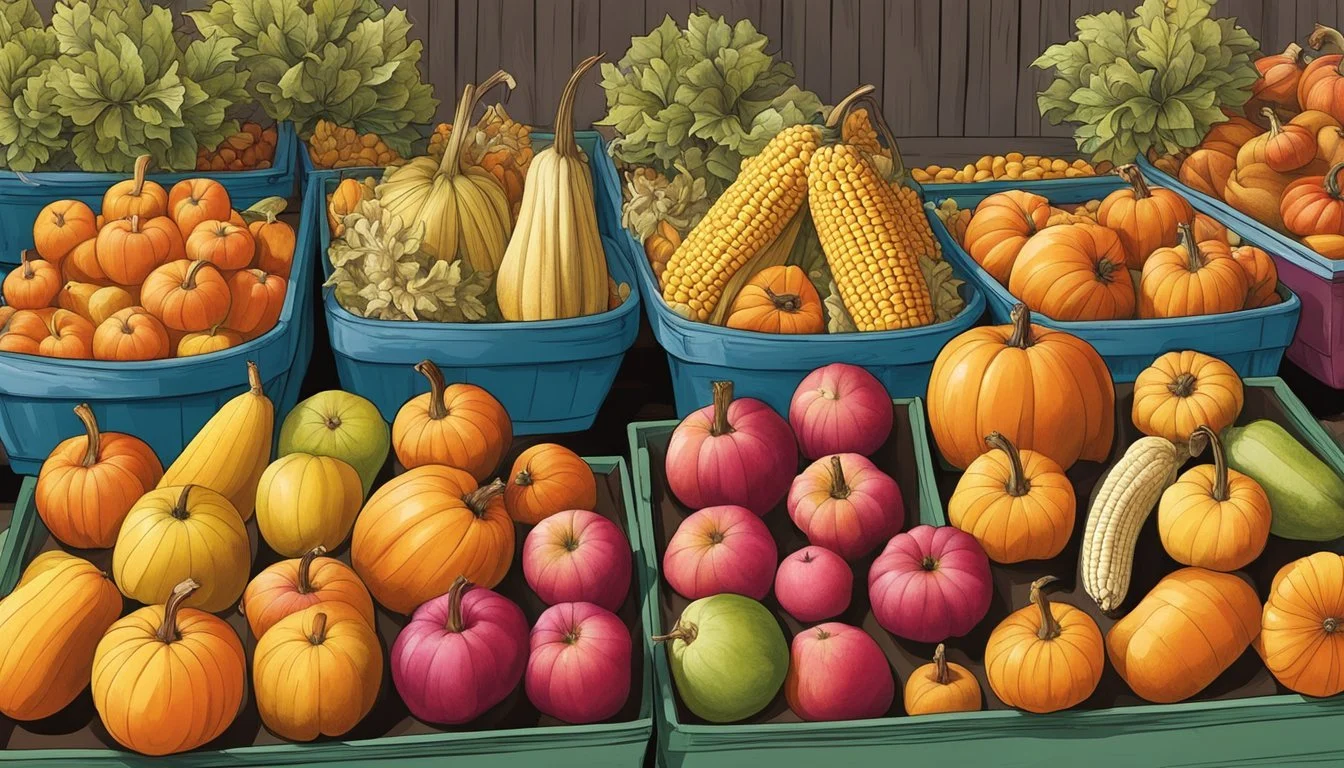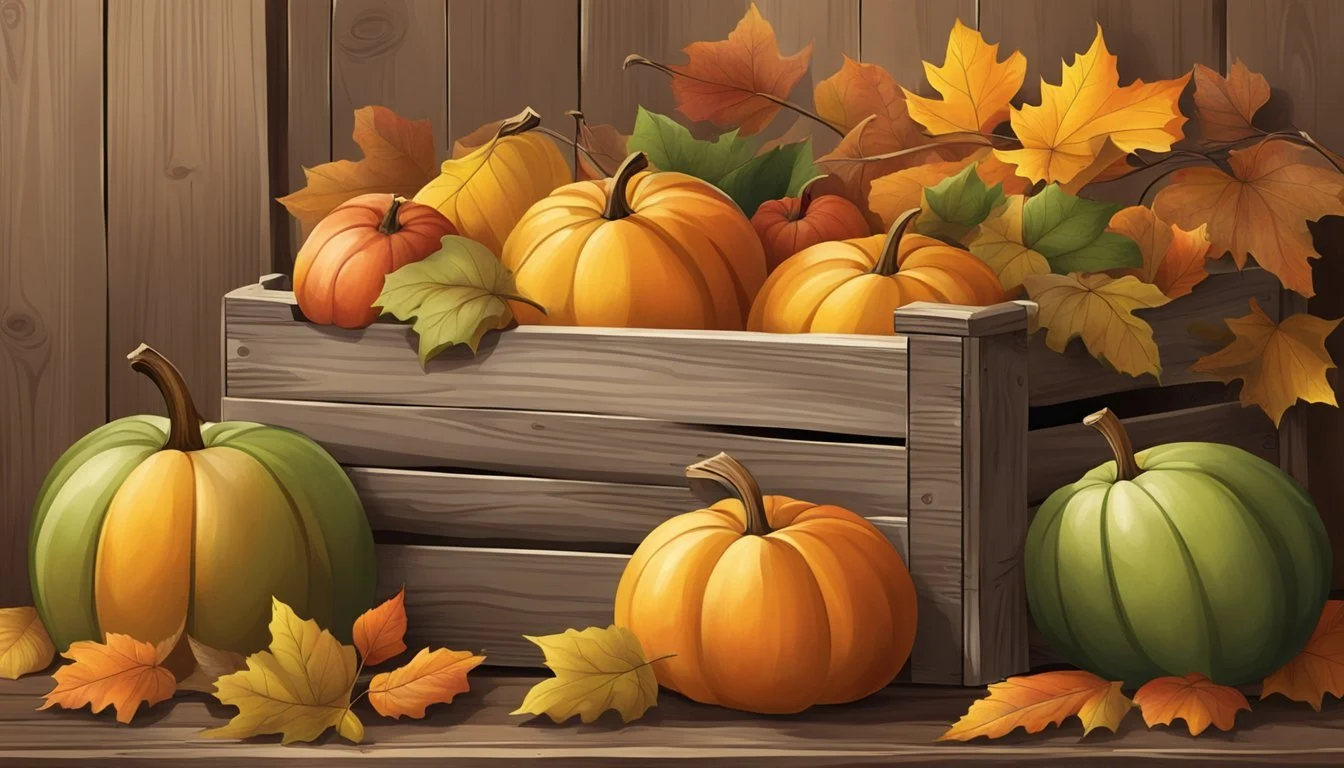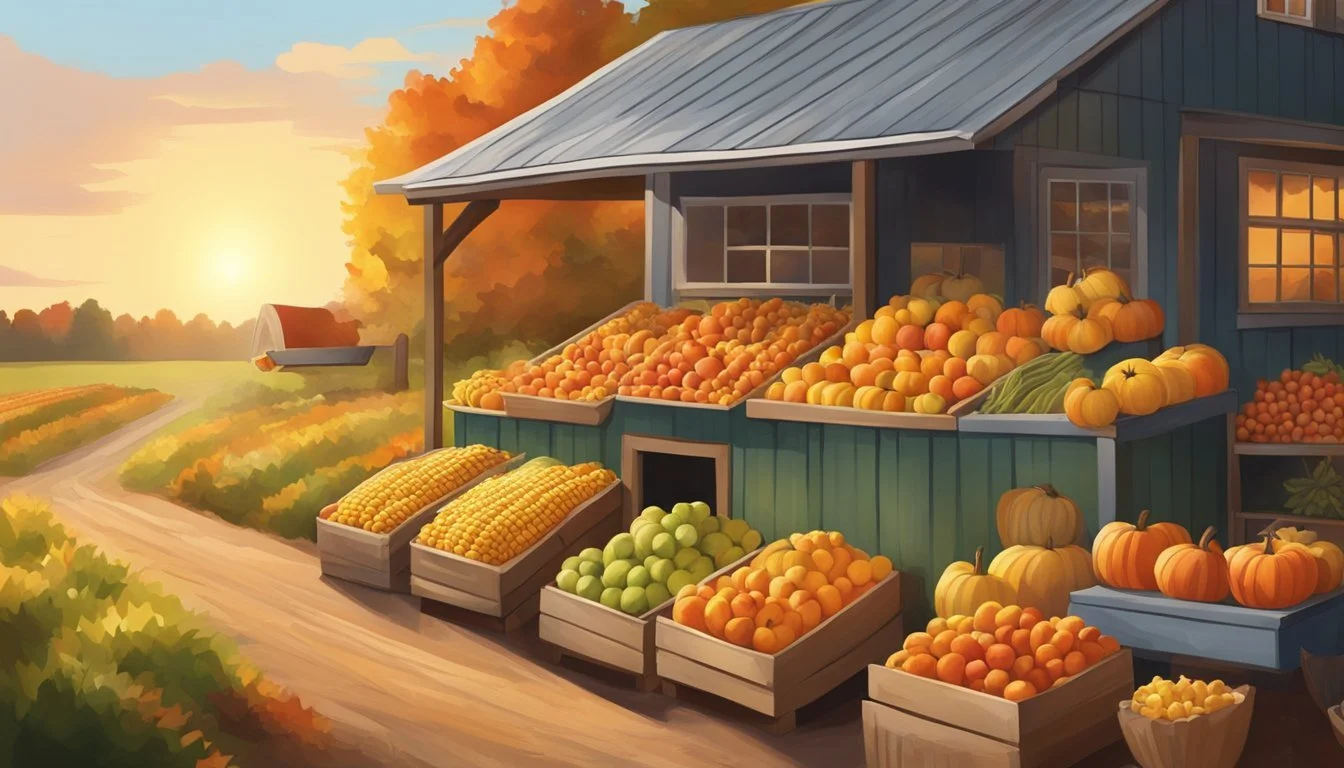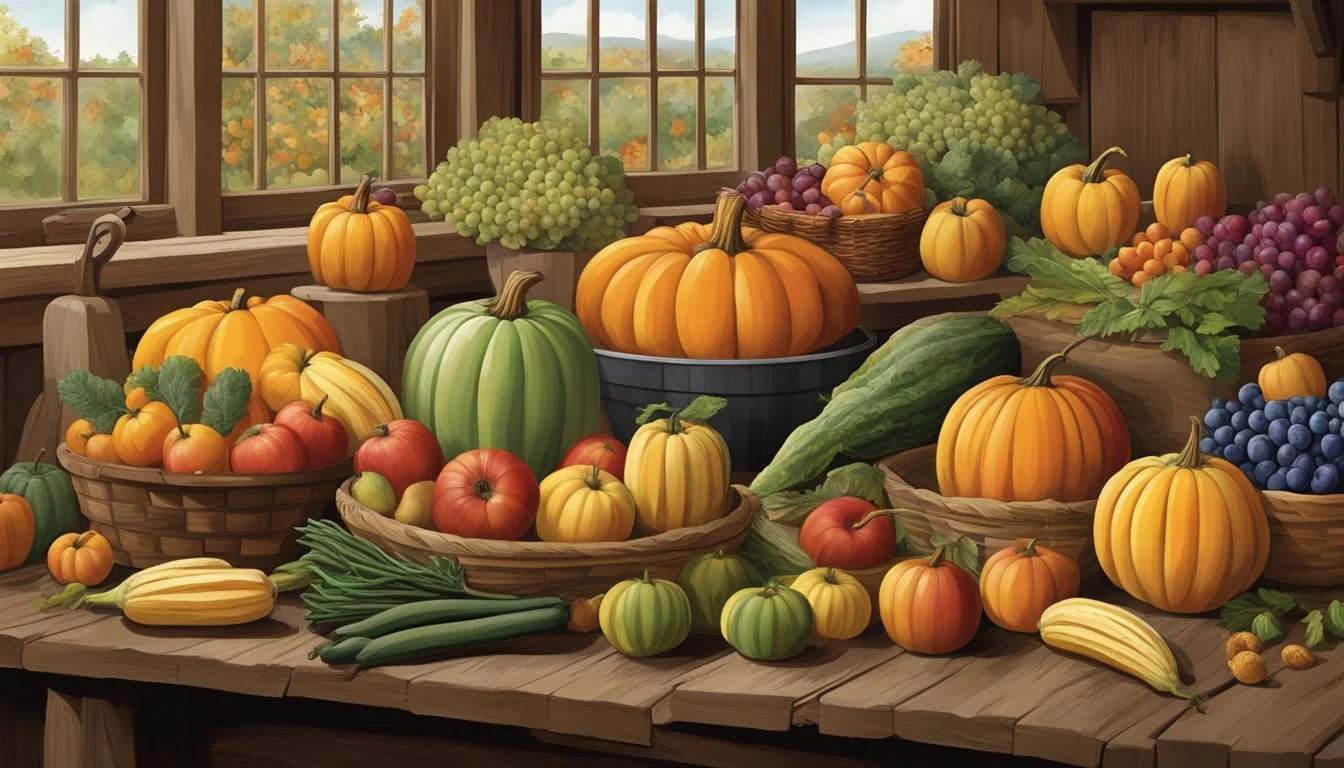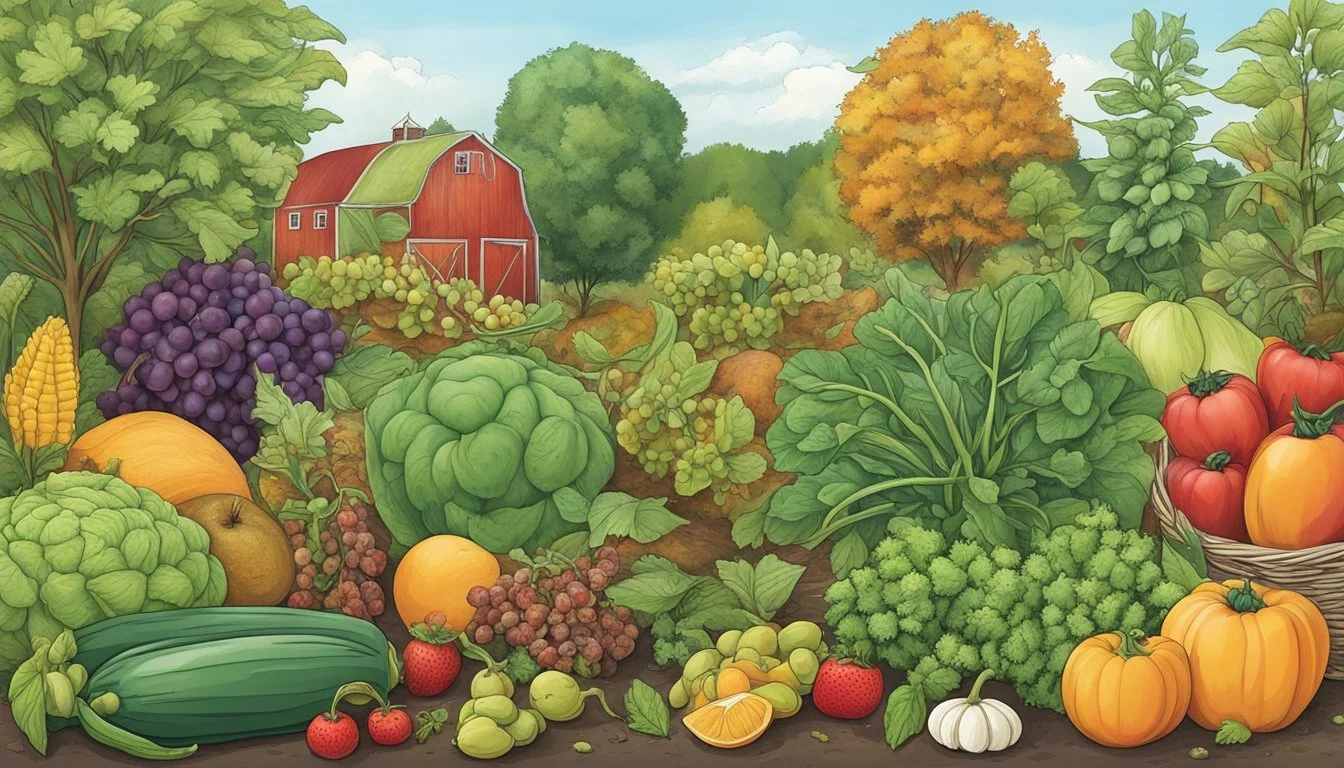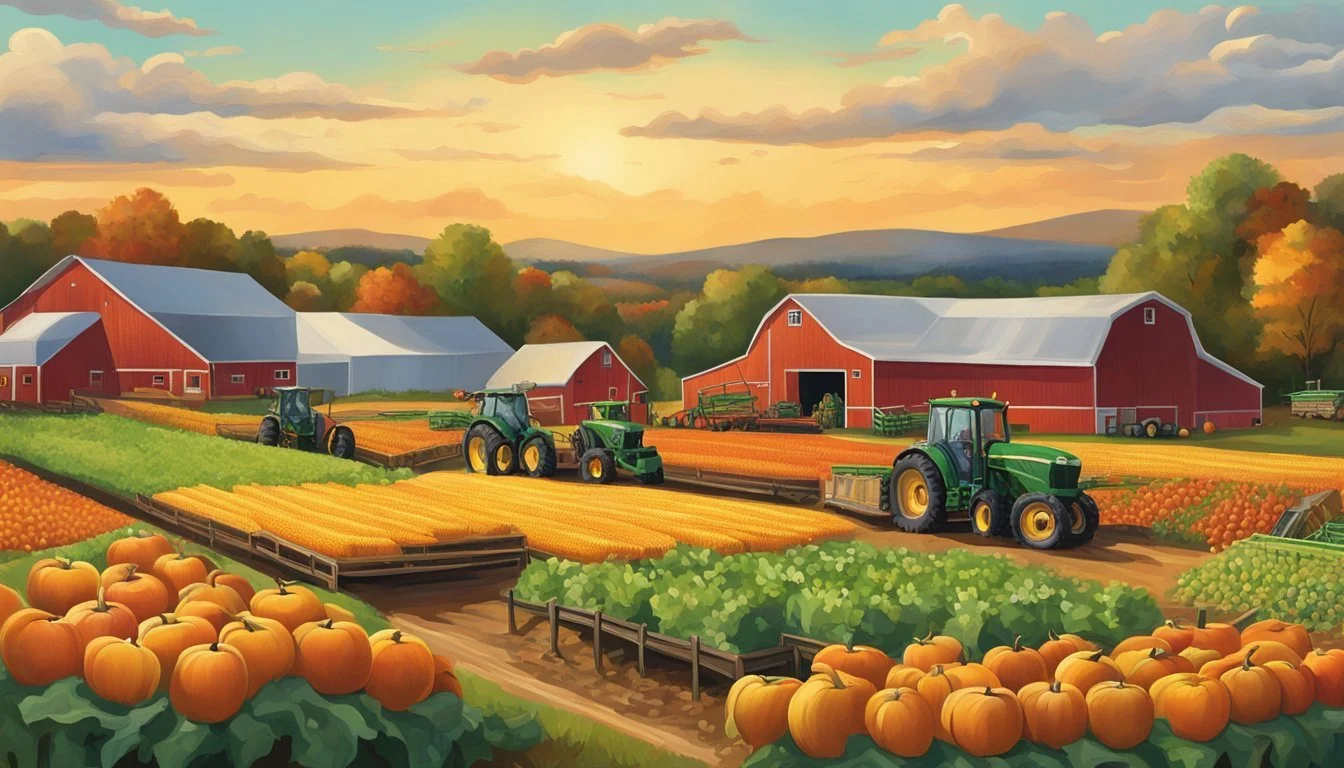New Hampshire Seasonal Fruit & Vegetables in September
Your Fresh Guide
This Article is Part of our New Hampshire Seasonal Fruit & Veg Calendar
September in New Hampshire marks a transition period for local agriculture, offering a diverse array of fresh fruits and vegetables as summer warmth gives way to the crispness of fall. During this month, the harvest reflects a blend of the late summer bounty and the first hints of autumn's offerings, making it a unique time for consumers to enjoy a variety of seasonal produce. The array of colors, textures, and flavors available provide ample opportunity for culinary exploration and support of local farms.
Apples (how long do apples last?) are a quintessential part of New Hampshire's September harvest, with varieties like Honey Crisp, Macoun, and Gala becoming ripe for picking. The state's apple orchards become bustling destinations for locals and visitors alike, who seek out the freshest fruit right from the trees. Vegetables, too, are abundant, including staples such as beans, beets, broccoli, and carrots. The convergence of these fruits and vegetables ensures that September is an optimal time for canning, baking, and preserving to capture the taste of the season.
Conscious of the region's climate and soil conditions, farmers in New Hampshire expertly cultivate crops that thrive in the Northeastern United States. The result is a selection of produce that not only supports the local economy but also offers a taste that is distinct to the region's agricultural heritage. As such, September's harvest connects consumers with the seasonality of food and the rhythms of the natural world in New Hampshire.
Overview of New Hampshire's Seasonal Produce
In September, New Hampshire's farms offer an impressive variety of fruits and vegetables, ripe due to the unique temperate climate. This period marks a significant transition from summer abundance to the early harbingers of fall.
Importance of Locally Grown Produce
Locally grown produce in New Hampshire is crucial for maintaining a sustainable food system. It supports the local economy and farmers while providing consumers with fresher, more nutritious options. September harvests are especially robust, as they include the last of the summer crops and the beginning of autumn's bounty.
Understanding New Hampshire's Growing Seasons
New Hampshire's growing seasons are relatively short, with a late spring and an early winter. However, September often sees an overlap of late summer produce and early fall varieties. Recognizing what is in season during this month helps in sourcing the freshest local produce and enjoying flavors at their peak.
September's Unique Climate Influence
The climate of New Hampshire in September is generally mild, which allows a variety of crops to thrive. The state's diverse topography affects local microclimates, meaning that produce availability may vary within different regions. The start of the cooler evenings and shorter days influence the growth and flavor profiles of the seasonal flavors, particularly encouraging the sweetness in apples and the richness in root vegetables.
Fruits in Season for September
In New Hampshire, September ushers in the harvest of a variety of fruits, from the last of summer's berries to the first of autumn's apples and pears.
Popular Fruits Harvested
Apples: A staple of September, orchards offer an array of varieties.
Honey Crisp: Harvested in mid-September
Macoun: Available late September
Gala: Often picked by late September
Pears: Another autumn favorite ripening in this month.
Varieties typically include local staples becoming ready to eat.
Berry Varieties
Raspberries: September still yields raspberry varieties, although toward the end of their season they may be less abundant.
Tree Fruits
Alongside apples and pears, other fruits from trees are commonly collected in September, including:
Peaches: The last batches of peaches are often harvested in early September if the weather permits.
Plums: Various plum types come to maturity and can be picked during this month.
Vegetables in Season for September
September in New Hampshire marks a time when the harvest of various vegetables is at its peak, with a bountiful supply of root vegetables, leafy greens, and a variety of nightshade vegetables and cucurbits available.
Root Vegetables and Tubers
Carrots and potatoes are two of the most prominent root vegetables harvested in New Hampshire during September. They are known for their versatility in the kitchen and long shelf life.
Carrots: A crunchy favorite, perfect for both raw and cooked dishes.
Potatoes: Available in several varieties, from starchy to waxy, suitable for a vast array of culinary uses.
Beets also belong to this category, offering their deep, earthy flavor and vibrant color to both savory and sweet dishes.
Leafy Greens and Stem Vegetables
Kale (What wine goes well with kale?) is one of the leafy green vegetables that thrive in September's cooler temperatures. It’s a nutrient-dense vegetable that maintains its texture well in cooking and can be enjoyed raw in salads.
Kale: Loaded with vitamins and minerals, with a sturdy texture that stands up to hearty preparations.
Many other greens and stem vegetables are also plentiful during this time, but the prominence of kale highlights its nutritional value and adaptability.
Nightshade Vegetables and Cucurbits
Tomatoes and cucumbers fall under the warm-season crops that are still harvested in September, although nearing the end of their season. These two vegetables are often valued for their fresh flavors.
Tomatoes: They can range from sweet cherry tomatoes to meaty heirlooms.
Cucumbers: Known for their crisp texture, making them a popular addition to salads and pickles.
This period is the last chance for gardeners and consumers to enjoy these vegetables fresh before the colder weather sets in.
Harvest and Storage Tips
In New Hampshire, September marks a time when a variety of fruits and vegetables reach optimal ripeness, making it crucial to employ proper harvesting techniques and storage practices to maintain their freshness and longevity.
Proper Harvesting Techniques
One must harvest vegetables such as cauliflower (how long does cauliflower last?) and bell peppers (What wine goes well with bell peppers?) when they are firm to the touch and have reached their full color. Apples and pears should be picked when they come away easily from the branch with a gentle twist. Checking for signs of fullness and a deep, consistent color can often indicate that the fruit or vegetable is ripe for picking. Vegetables like green beans should be harvested before they become too large and tough.
Storage Practices for Longevity
Storage conditions play a pivotal role in preserving the freshness of harvested produce. Apples, commonly abundant in September, should be kept in a cool, dark place or refrigerated to slow down ripening. They can be stored for several weeks under proper conditions. Vegetables such as bell peppers and cauliflower are best kept in the crisper drawer of a refrigerator, where humidity levels help maintain their crispness. It’s essential to ensure that the produce is dry before storage to prevent spoilage.
Table: Sample Storage Guidelines for Select September-Harvested Produce
Produce Ideal Storage Condition Expected Shelf Life Apples Cool, dark place or refrigerated Up to 4 weeks Bell Peppers Refrigerated in crisper drawer, dry 1-2 weeks Cauliflower Refrigerated in crisper drawer, dry 1-2 weeks Green Beans Refrigerated in airtight container, dry Up to 1 week
By adhering to these harvesting and storage techniques, one can maximize the shelf life and quality of New Hampshire's September bounty.
Health Benefits of Seasonal Eating
Eating seasonally aligns the consumption of fruits and vegetables with the time of year they are naturally ripe and ready to eat, which optimizes nutrient intake and promotes better health.
Nutritional Advantages of Fresh Produce
Freshness and Nutrition: Seasonal fruits and vegetables, harvested at their peak, boast higher levels of vitamins, minerals, and antioxidants. For example, vitamin C is more abundant in produce such as strawberries and bell peppers when they are fresh. The longer fruits and vegetables are stored, the greater the nutrient loss—thus, consuming them during their natural harvest season can maximize their health benefits.
Variety and Diet Diversity: Seasonal eating naturally varies one's diet. This diversity can lead to a broader intake of essential nutrients, as different produce offers different nutritional profiles, encouraging a more balanced and comprehensive diet.
The Impact of Seasonal Eating on Well-being
Immune Support and Disease Prevention: Fresh, seasonal produce tends to have higher nutrient content, which is vital for maintaining a healthy immune system. Nutrient-dense foods contribute to overall well-being and can help prevent chronic diseases. For instance, antioxidants found in seasonal berries and leafy greens help protect the body against cellular damage and inflammation.
Mental Health: There is also evidence suggesting a diet rich in fresh, seasonal fruits and vegetables can have a positive impact on mental health. The myriad nutrients, such as folate from dark leafy greens and omega-3 fatty acids found in certain seasonal fish, support brain function and may contribute to improved mood and cognitive health.
Supporting Local Agriculture
Supporting local agriculture in New Hampshire means participating in a thriving economy built on the foundations of community and sustainability. In September, this involves a focus on seasonal fruits and vegetables available through various local channels.
Farmers Markets and Community-Supported Agriculture
Farmers markets in New Hampshire serve as vibrant hubs for the exchange of fresh, locally grown produce. These markets are critical in September for the distribution of seasonal items such as apples, pumpkins, and squash. Community-supported agriculture (CSA) programs add another layer, allowing consumers to subscribe for regular shares of the harvest, fostering a direct connection with the farmers and the land. By committing to local farms, consumers ensure consistent support throughout the growing season.
Farmers Markets: Provide fresh seasonal produce; encourage direct support of local farmers.
CSA Programs: Offer subscription-based shares of the harvest; promote ongoing commitment to local agriculture.
The Role of Local Farms in New Hampshire's Economy
The local farms in New Hampshire play a pivotal role in the state's economy. Agriculture contributes significantly to the economic landscape, offering employment and sustaining rural communities. By producing a diverse array of crops and goods, local farms help to stabilize the local food system and reduce the reliance on imported foods, which in turn strengthens economic resilience.
Economic Contribution: Employment for locals; sustenance of rural communities.
Diversification: Aids in economic resilience; reduces food import reliance.
Local agriculture embodies the collective effort of farmers, consumers, and the community at large to create a robust and self-sustaining economy throughout New Hampshire.
Seasonal Recipes and Preparation Ideas
In New Hampshire, September's bounty offers a cornucopia of fruits and vegetables ideal for creative and healthy meals. The following recipes and preservation techniques make the most of the harvest while ensuring flavors can be enjoyed long into winter.
Simple and Nutritious Recipes
Apple Cinnamon Baked Oatmeal: A warm, inviting breakfast that incorporates fresh September apples, topped with a hint of cinnamon for a comforting start to the day.
Kale and Brussels Sprout Salad: These hardy greens, at their peak in September, make for a nutritious salad base. Toss with a light vinaigrette and sprinkle with roasted seeds for a crunch.
Roasted Carrot Soup: Hearty and vibrant, this soup brings out the natural sweetness of carrots harvested in September. Serve with a swirl of cream and fresh herbs for added flavor.
Preserving the Harvest for Winter
Apple Preserves: Cook down September's apple harvest with sugar and spices to create jams and preserves that will last through the winter months.
Blanching and Freezing Vegetables: Vegetables like beans and kale can be blanched and frozen, maintaining their nutritional quality and flavor for winter use.
Root Cellar Storage: Carrots and potatoes, harvested in September, can be stored in a root cellar where they will remain fresh and usable through the winter season.
By incorporating these recipes and preservation methods, one can fully utilize September's harvest while preparing for the colder months ahead.
Planning and Planting for Future Seasons
Gardeners in New Hampshire should utilize the month of September to plan and prepare their gardens for future growing seasons. Accurate knowledge of frost dates and appropriate planting schedules is essential for a successful garden.
Gardening Tips for Beginners
For neophyte gardeners, it’s crucial to understand that the success of a garden hinges on the selection of plants suitable for the coming seasons. Spring is an opportune time to start a garden, but one must remember that certain crops fare better when planted in fall. Here are specific actions they should take:
Research: Beginners should identify plants that thrive in New Hampshire's climate and are capable of withstanding its winter.
Soil Preparation: Fall is the perfect time to enrich the garden soil with compost and other organic matter, ensuring that by spring, the soil is nutrient-rich and ready for planting.
Understanding Frost Dates and Planting Schedules
Knowledge of frost dates is paramount for gardeners in New Hampshire since they influence when to plant and harvest. Here’s what gardeners should remember:
Frost Dates: The first frost in New Hampshire can occur as early as the first week of September. This information dictates the planting schedule to ensure crops mature before the frost hits.
Planting Schedules: Utilizing a tailored planting schedule that takes into account local hardiness zones is beneficial. In New Hampshire, this means acknowledging that the state spans USDA Hardiness Zones 3-6.
Month Action June Plan for late summer and fall harvests. July Begin planting fall-harvested crops. August Continue planting and start early fall prep.
By considering these factors, gardeners can maximize their harvest and extend the growing season.
Dealing With Pests and Plant Diseases
In September, New Hampshire's harvest is at a critical phase, and managing pests and diseases becomes paramount to ensure the health and yield of fruit and vegetable crops.
Common Pests in September
During September, growers face an array of pests that can compromise the integrity of their crops. They typically contend with:
Aphids: These small insects cluster on the undersides of leaves, weakening plants by sucking sap.
Tomato Hornworms: Large green caterpillars that target tomato plants, causing significant defoliation.
Apple Maggots: Fly larvae that tunnel into apples, leaving fruit unsuitable for consumption or sale.
Preventive Measures and Natural Remedies
To address pest issues, it is essential to adopt a variety of management practices:
Cultural Controls
Crop Rotation: Alternate planting locations to disrupt pest lifecycle.
Sanitation: Regularly remove plant debris to reduce pest breeding grounds.
Biological Controls
Beneficial Insects: Encourage populations of natural predators like ladybugs and lacewings.
Chemical Controls
When necessary, the application of pesticides should be done judiciously with a focus on products with low environmental impact. Always adhere to integrated pest management (IPM) techniques to minimize pesticide use.
Natural Treatments
Neem Oil: A natural pesticide that can deter a variety of pests without harming beneficial insects when used correctly.
Diatomaceous Earth: Effectively controls pests like aphids and slugs by dehydrating them upon contact.
Agricultural Resources and Support
In New Hampshire, growers have access to a wealth of agricultural resources and support systems designed to enhance the productivity and sustainability of their fruit and vegetable crops, particularly during the peak harvest months like September.
Extension Services and Expert Advice
Extension services in New Hampshire offer a comprehensive network of expert advice and support for local farmers. Through these services, growers can access research-based knowledge tailored to the state's unique climate and soil conditions. Extension specialists provide insights on best practices for crop management, pest control, and harvest techniques.
Resources Available:
Workshops and seminars on agricultural best practices.
Publications and guides on seasonal crop management.
Personalized farm consultations.
Support Provided:
Troubleshooting crop issues with the help of horticultural experts.
Access to the latest research on sustainable farming methods.
Assistance with the adoption of new technology in agriculture.
Nurseries and Greenhouses
Nurseries and greenhouses within the state serve as essential resources for New Hampshire's agricultural community. These facilities provide quality plants and seedlings that are well-suited to the local climate.
Nursery Services:
A diverse selection of fruit and vegetable plant varieties.
Expert guidance on plant selection and crop rotation.
Greenhouse Advantages:
Controlled environments for year-round plant cultivation.
Enhanced plant protection from unpredictable weather.
Early start for seedlings, leading to robust crops.
Conclusion
September in New Hampshire is an abundant month for local produce. Farmers' markets and local stands brim with a variety of fresh fruits and vegetables. It is pivotal for consumers interested in seasonality to recognize the wealth of options available to them.
Fruit Highlights:
Apples: A prime time for various apple varieties.
Pears: At their peak, offering juicy sweetness.
Plums: Still available, succulent and rich in flavor.
Vegetable Highlights:
Tomatoes: Ripe and plentiful, perfect for canning or fresh salads.
Sweet corn: Its tenderness is unmatched during this month.
Leafy greens: Kale and spinach thrive in the cooling temperatures.
Farmers in New Hampshire take pride in their commitment to sustainable agriculture. They tend to offer what is known to flourish in the New England climate. The aforementioned produce represents just a slice of the region's bounty.
Patrons of New Hampshire's harvest should take advantage of September's offerings. They can expect freshness, local quality, and a taste reflective of the region's unique terroir. It is beneficial for both the local economy and for one's health to choose produce that is in season.
Embracing what the land provides strengthens the connection between consumer and environment. It allows one to savor the season's flavors and supports the local communities that work diligently to bring these harvests to the table.

